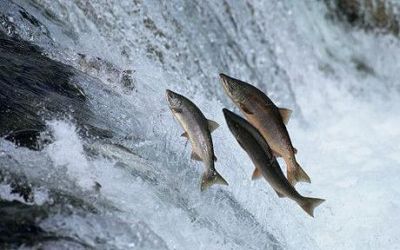| |
Witajcie !
Jak już wszystkim wiadomo, mam przyjemność ogłosić temat obecnego weekendu:
HAIRWING SALMON FLY
Cóż to kryje się pod tą nazwą?
mucha łososiowa ze skrzydełkiem z sierści
abyśmy mogli pokombinować, aby każdy kto chce mógł skręcić taką muchę - sierść niech
będzie dowolnego pochodzenia. jedyne czego dobrze byłoby uniknąć - nie robimy
muchy na tubie czyli haczyk pojedynczy łososiowy, double i kotwiczka - jak najbardziej.
Tubom mówimy w tym weekendzie stanowcze NIE 
Przypomnę zasady:
1. Weekend trwa od piątku do końca niedzieli.
2. Każdy uczestnik wstawia jedną muchę.
3. Wybór działu jest dowolny.
4. Każdą muchę opisujemy - z jakich materiałów jest wykonana.
5. W " Uwagi " wpisujemy " Weekend z Imadłem ".
6. Dobrze się bawimy 
7. Uczymy się 
8. Muchy przekazujemy na aukcje charytatywne
A teraz: trzymam kciuki za Wasze muchy łososiowe 
Adam
P.s. krótka historia much łososiowych, w łososiowym języku urzędowym ( trudno tłumaczyć
na język polski ):
Although salmon fly fishing was fairly widely practised in Scotland as early as the
eighteenth century, it was not until the nineteenth century that the development of the Salmon
fly really took off. The art of the salmon fly dresser reached its height in the Victorian era,
when the earlier rather drab Scottish fly patterns of William Scrope (e.g. Meg in her Braws,
Kinmont Willie) were supplanted by a flood of highly complex and exotic creations (Jock
Scott, Silver Doctor, Dusty Miller, Mar Lodge). The popularity of these gaudy patterns
continued into the twentieth century when they were gradually modified, simplified and
supplemented by more sensible salmon flies. First the low water style of fly dressing was
applied to earlier patterns (Logie, Jeannie, Blue Charm). Then, particularly from the 1950's,
began the development of the modern hairwing salmon fly (Hairy Mary, Garry, Stoat's Tail,
Munro's Killer), which we know so well today. Recent years have seen wide ranging
developments in salmon fly design, including the slim stainless needle tubes developed by
Grays of Kilsyth.

|